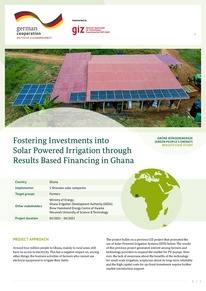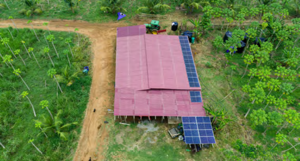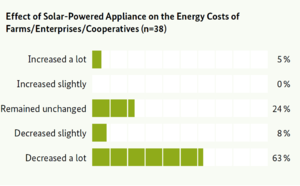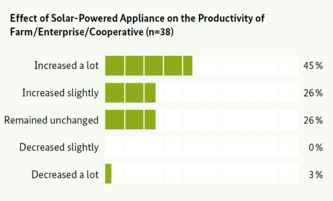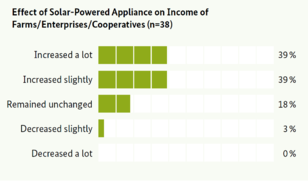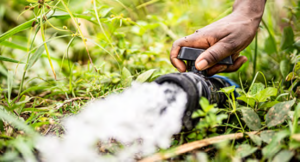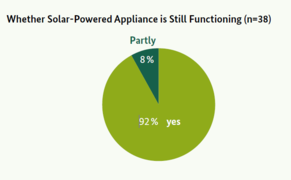Click here to register!
Difference between revisions of "Fostering Investments into Solar Powered Irrigation through Results Based Financing in Ghana"
***** (***** | *****) |
***** (***** | *****) Tag: 2017 source edit |
||
| Line 49: | Line 49: | ||
*</div><!-- End .moz --><div style="visibility:hidden;position:absolute;">{{GBE ProjectDB | *</div><!-- End .moz --><div style="visibility:hidden;position:absolute;">{{GBE ProjectDB | ||
|GBE financed=Country Component | |GBE financed=Country Component | ||
| − | |GBE country= | + | |GBE country=Ghana |
}}</div> | }}</div> | ||
Latest revision as of 09:32, 20 March 2024
Fostering Investments into Solar Powered Irrigation through Results Based Financing in Ghana
Project Approach
Around four million people in Ghana, mainly in rural areas, still have no access to electricity. This has a negative impact on, among other things, the business activities of farmers who cannot use electrical equipment to irrigate their fields. The project builds on a previous GIZ project that promoted the use of Solar-Powered Irrigation Systems (SPIS) before. The results of this previous project generated interest among farmers and technology providers to expand the market for PV-pumps. However, the lack of awareness about the benefits of the technology for small-scale irrigation, scepticism about its long-term reliability and the high capital costs for up-front investment require further market introduction support. The project supports the market development of SPIS through a results-based financing (RBF) scheme. The scheme is introduced through a comprehensive approach with several elements. First, it mobilises and sensitises farmers to the benefits of solar energy and its potential impact on agriculture. This helps to create awareness and generate interest among the farming community. Second, a complementary team of agricultural and solar energy experts from the Brew Hammond Energy Centre of Kwame Nkrumah University of Science & Technology is established.This team provides guidance and support to farmers in terms of selecting the best solar solutions for their specific needs.
The team also provides advice and training to farmers on the use, maintenance, and repair of the solar technologies they purchase, promoting effective and sustainable use of the equipment. Third, the project partners with Ghanaian solar energy companies to offer their products and services to farmers. This gives farmers access to the latest solar technologies and products designed specifically for agricultural use. Finally, the RBF programme provides incentives to 5 selected solar companies which reduces the amount of investment paid by the farmers. The incentive is 40 % of the total price of the SPIS, in case of female customers 50 %. The incentive is paid to the solar companies after successful testing and commissioning of the installed SPIS. The contractual relation is just between the 5 solar companies and GIZ.
Methodology of Data Collection
Data for this case study report was collected through a review of project documents, five qualitative interviews with representatives of GIZ, the Ghana Irrigation Development Authority (GIDA), one solar company, the Brew Hammond Energy Centre of the Kwame Nkrumah University of Science & Technology, and the Centre for Indigenous Knowledge and Organisation Development (CIKOD), of which several beneficiaries are members. Further, 54 farmers were contacted to participate in a quantitative survey (of which 41 % were women). 42 of the farmers participated in the survey. The case study was carried out between January and May 2023.
Key Findings
Project Achievements
54 farmers purchased and installed a SPIS powering a 2.5kWp average-size pump using the incentive scheme provided. These pumps irrigate farmlands in a range of 1 to 30 acres depending on the pump capacity and available water source. The RBF provided the farmers with the financial support they needed to invest in these technologies and improve their farming efforts. Almost 90 % of the farmers use their solar pumps frequently or sometimes.The SPIS reduce ongoing energy costs. Specifically, the majority of the respondents (63 %) report a significant reduction in energy costs after installing SPIS, while 8 % report a slight reduction in costs. Interviewees indicate that SPIS has helped farmers save money that was previously spent on fuel and transport costs to petrol stations. In the past, some farmers had used generators for irrigation, which was expensive and unreliable.On the other hand, 24 % of the farmers report that costs remained the same, with the remaining 5 % stating a significant increase in energy costs (see Figure 1).
The response of these 5 % of survey participants can largely be explained by the fact that they did not previously have a fossil fuel-powered appliance and thus had no energy costs at all. Overall, the results indicate that the use of SPIS is a cost-effective solution for farmers wishing to reduce their energy expenses. The SPIS project has revolutionised the way farmers irrigate their crops. With this modern technology, farmers can significantly reduce their irrigation time. Some farmers who did not previously have a diesel-powered pump have reduced their time from 6 hours to just 45 minutes. In this way, the project has facilitated important access to electricity for farmers, which has had a number of positive outcomes.
Intermediate Impact
The use of solar technology is reflected in increase of productivity (see Figure 2). 45 % of farmers report a significant increase, while 26 % report a slight increase in productivity due to the SPIS. Only 3 % of the farmers report a significant decrease in productivity, while the remaining 26 % report no change. The increase in productivity explains why some 23 % of farmers have been able to reduce their labour force as a result of the SPIS. On the other hand, 40 % have hired additional labour, e.g. due to expanded business activities. In addition to productivity gains, some 78 % of farmers also report an increase in income (see Figure 3).Interviewees note that farming throughout the year, rather than just two seasons, has had a significant impact on farmers’ incomes and profits, and has significantly improved their families’ living conditions. This increased income has enabled some families to access quality education for their children and necessary healthcare services. Furthermore, the implementation of SPIS has enabled farmers to save time and prioritise their family’s welfare while participating in social activities. Some farmers have even started new small businesses, increasing their income and contributing to their economic growth.
Climate Impacts
Using the calculation methodology of the United Nations Framework Convention on Climate Change (UNFCCC), the installations described above are estimated to mitigate 125.08 t CO2 e/a in the year of installation by avoiding and/or replacing the use of fossil fuels. This is roughly equivalent to the annual CO2 emissions of more than 89 medium-sized cars in Germany.
Challenges in Project Implementation
68 % of farmers see the high costs of purchasing the SPIS as a challenge despite of the incentive offered through the RBF. Very few people mention insufficient energy generation or lack of funds for maintenance and possible repairs as challenges. Stakeholders also confirm that the financial stability of the farmers is an essential aspect to be considered. GIZ has provided incentives to support the solar market in rural areas. However, many farmers have struggled to pay their part of the SPIS costs in advance. The installation companies waited for the farmers to complete their payments resulting in delays in the installation of the SPIS.The adoption of SPIS by farmers has been impeded by their past experiences with installer companies that have provided them with inferior SPIS. These inadequate systems resulted in significant financial losses for the farmers, leading to a loss of trust and a negative perception of irrigation systems provided by solar companies. Despite their many benefits, this has created a significant barrier to the widespread adoption of SPIS. The project met this challenge by introducing specific control measures such as a technical and performance specifications checklist, which had to be met by every solar pump system before being approved to be installed. The project also conducted two field visits per customer to verify the proper installation: One visit to verify the technical soundness of the solar company´s offer to the farmer before installation, and a second field visit for the testing and commissioning of the installed SPIS.
Lessons Learned
Smallholder farmers have limited and highly fluctuating cash flow, and this is closely linked to the cropping seasons. Thus, payments must be linked to the harvest. Giving farmers the flexibility to pay their contributions in instalments is therefore crucial to facilitating their financial stability. Given the financial constraints and uncertainties that farmers often face, such an option can be a significant relief for farmers struggling to make lump sum payments. Furthermore, pre-inspections of the farm sites by solar companies are necessary to provide farmers with adequate equipment. Simply obtaining information from farmers without visiting the sites has proven to be insufficient, as the information provided is often not reliable or incomplete. In addition, it is crucial to enforce a supplier guarantee to rebuild farmers’ trust in SPIS suppliers. In this way, farmers can rely on the products they receive to improve their crop production.
Sustainability of the Intervention
Farmers who opt to install SPIS are covered by a comprehensive two-year warranty. This warranty includes a thorough maintenance service provided by the installer to ensure that the system is dealt with promptly in the event of a malfunction. In addition, the installer commits to conduct regular checks to ensure that the SPIS is performing optimally. After the two-year warranty, the end-users have to pay the supplier for further major maintenance and repair works. It is expected that such costs will be covered through the increased incomes.Farmers have also been trained in the basic operation and maintenance (O&M) of the SPIS and a basic O&M manual was designed and shared with them. The manual includes the contact details of the solar pump installers. This training enables the farmers to handle minor issues themselves, saving them time and money whilst ensuring proper operation of their systems. SPIS technical training was also provided to several technical experts from the Ministry of Energy and GIDA, who will follow up with technical support and operation and maintenance trainings for the farmers after the GBE-intervention has come to an end. The guarantee and the training of the farmers contribute to the sustainable functioning of the solar pumps. At the time of the case study, 92 % of respondents state that their solar pump is still functioning. However, 8 % state some limitations in functionality (see Figure 4).SPIS provides a sustainable water supply, enabling farmers to grow crops throughout the year, and not only during rain season. This development is a positive step towards long-term food security and economic stability for the project beneficiaries.
Conclusion and Outlook
In view of the results obtained, the RBF approach chosen appears to be suitable for promoting the installation of SPIS in rural areas. The main challenge identified in the interviews and in the survey, namely the high upfront costs of installation, shows that financial incentives or appropriate loan schemes are needed for many farmers to invest in a SPIS. For the majority of farmers, the investment made leads to increased productivity, increased income, as well as cost and time savings. Considering that 89 % of the farmers surveyed have recommended the purchase of a SPIS to other farmers interested in purchasing one, and 21 % of the respondents even know other farmers who have purchased a solar-powered appliance as a result of their example and/or advice, it is plausible to assume that the project will lead to upscaling effects beyond the end of the project. Lastly, the availability of a two-year warranty and access to further after-sales services combined with capacity building on operation and maintenance among the farmers are essential factors for the long-term sustainability of SPIS.

